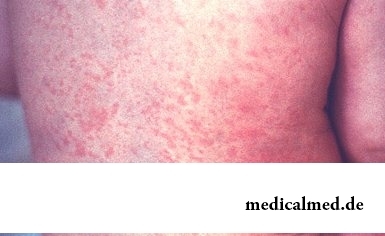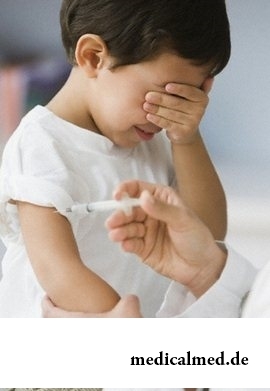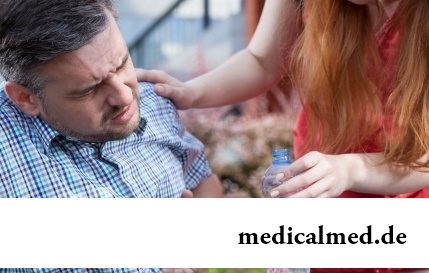





Rubella
General information about a disease
 The rubella is understood as an acute viral infection which belongs to the category of so-called children's infections, that is, most often it meets at children's age. The name of a disease "rubella" came from characteristic color of rash which for several days covers a body of the sick person.
The rubella is understood as an acute viral infection which belongs to the category of so-called children's infections, that is, most often it meets at children's age. The name of a disease "rubella" came from characteristic color of rash which for several days covers a body of the sick person.
The rubella is known to doctors since the Middle Ages, and and in those days it was widespread almost everywhere. Nevertheless, throughout many centuries scientists considered that the rubella at children is absolutely harmless. Communication of a disease with pre-natal child mortality and inborn uglinesses at kids was proved only in the forties the last century then rubella inoculation was included in national calendars of vaccination of dozens of countries of the world.
What causes a rubella and as it is transmitted?
The causative agent of a rubella is the virus from group of togavirus. From the person to the person he is given in the airborne way at direct contact with infected. Also the transtsplatsentarny way of transfer of a rubella at which the child catches in mother's womb when the virus passes to a fruit through a placenta is also known.
The causative agent of a rubella can exist comfortably only in a human body. In external environment he quickly perishes because of ultraviolet rays, change of pressure, insufficient humidity and high temperature. In the conditions of low temperatures the virus, on the contrary, lives long and keeps productive capacity within several years.
Insidiousness of a virus of a rubella is that the incubation interval of a disease lasts from 2 to 3 weeks. Respectively, the sick person becomes infectious long before the first adverse signs are shown. Let's notice also that at the diagnosis a rubella symptoms at children can be absent in general. As a result, one sick child quite often infects all surrounding, and doctors bethink only when children have characteristic rashes on a body.
The outbreaks of a rubella happen time in 5-7 years. Annual aggravations happen during the spring and summer period, but do not constitute special danger because of efficient preventive actions. The last case of large-scale epidemic was registered in the 60th in North America. Then more than 20 million people had, and after the outbreak of a rubella at thousands of pregnant women children with these or those inborn uglinesses were born.
Rubella types
Depending on a way of infection, the rubella at adults and children is subdivided into two look:
- the acquired rubella – proceeds in the most various forms, is followed by emergence of rash on a body, but can have also an atypical clinical picture of development at which rash is not formed. Besides, in 30% of cases any symptoms of a rubella in general are absent that considerably complicates statement of the correct diagnosis and provokes distribution of epidemics. Usually the disease proceeds in an easy or medium-weight form, and patients are treated at home. Hospitalization is shown only at emergence of heavy complications which, however, are extremely rare;
- the inborn rubella – is much more serious, than the acquired infection. It concerns both manifestations, and possible effects among which it is possible to note especially defeats of a nervous system, heart diseases, disturbances in work of eyes and acoustic organs.
Due to the aforesaid there is a wish to make one essential remark: the rubella occurs at adults rather seldom as an overwhelming part of people have in the childhood, and the received immunity remains for life. At the moment not less than 85% of women have immunity to an infection by the time of approach of reproductive age.
Rubella symptoms
The acquired form of a rubella proceeds cyclically. Symptoms of a rubella begin with:
- indispositions;
- headache;
- short-term fervescence;
- joint pains;
- emergence of melkopyatnisty rash of pink color (appears for 2-3 days of a disease, extends on all of a body).
Unlike measles, separate elements of rash have no tendency to draining and disappear without pigmentation or a peeling. Characteristic symptoms of a rubella – a hyperadenosis on a neck and in occipital area. Symptoms of fever and intoxication or are insignificant, or completely are absent. In many cases the disease proceeds in an inappartny form when rubella symptoms at children are expressed very poorly that results in impossibility of statement of the correct, timely diagnosis.
Treatment of a rubella
 Treatment of a rubella is usually carried out in house conditions. The child needs to provide a bed rest, good nutrition, vitamin-rich, plentiful drink (preference is given to juice and fruit drinks, carbonated drinks – are excluded).
Treatment of a rubella is usually carried out in house conditions. The child needs to provide a bed rest, good nutrition, vitamin-rich, plentiful drink (preference is given to juice and fruit drinks, carbonated drinks – are excluded).
Specific treatment of a rubella is not carried out. Specialists watch a condition of the child, use symptomatic means. At emergence of complications urgent hospitalization is shown, but as it was already told above, need for it arises extremely seldom. Forecasts of treatment – favorable. In most cases the rubella disappears several days later and does not lead to serious effects. After healing of people gains lifelong immunity. Cases when the rubella at adults was shown repeatedly are known to medicine, but these are the most rare exceptions caused by features of immune system of the person.
For prevention of epidemics the preventive rubella inoculation and isolation of the infected children is used. It is very important to exclude communication of the sick child with pregnant women as at future mothers without immunity it can lead to fruit malformations.
Vaccination of the population is included in a national calendar of inoculations. The vaccine is entered intramusculary or subcutaneously when the child is one year old. Revaccination from a rubella becomes in 6 years. Specific immunity appears at 100% vaccinated and remains during all life.
The weight of a human brain makes about 2% of all body weight, however it consumes about 20% of the oxygen coming to blood. This fact does a human brain extremely susceptible to the damages caused by shortage of oxygen.

The saying "the rich do not know how the other half lives" is known to all. In a broad sense it is that we can not always understand the person, about...
Section: Articles about health
Good appetite was always considered as a sign of good health. The correct operation of the mechanism which is responsible for the need for nutrients and receiving pleasure from process of its satisfaction demonstrates that the organism functions without special from...
Section: Articles about health
At this plant there are a lot of names: tuberiferous sunflower, Jerusalem artichoke, solar root, earth pear. Contrary to popular belief, it is not an exotic plant at all. The wild girasol grows in a midland of Russia practically everywhere: at the edges of roads, to slopes of ravines, on heathlands. Also several cultural versions different from wild plants are removed by larger and juicy root crops....
Section: Articles about health
During foot walks blood moves on vessels more actively and one and all bodies are supplied with a large amount of oxygen. N...
Section: Slideshow
Cold is such painful that each sigh becomes a victory, heat "knocks" down, and the ache in joints forces to think only of pain. Some people with approach of the first symptoms of cold make the self-sacrificing decision to have a disease standing, and to a beam...
Section: Articles about health
The kid who was recently born is surrounded with love of adult family members and their cares without which the baby cannot exist. Some parents consider that gentle attachment and caress are quite enough that the child correctly developed and was happy, but it not so. It is important to know as much as possible about specifics of care of the baby, the reasons of his behavior and possible problems. Only the "able to see" love will provide to the little man that it is necessary for him....
Section: Articles about health
Each of us faces from time to time that other people need the immediate help. We react to it on-raznomu:...
Section: Articles about health
Small appetite at the child – the complaint which pediatricians should hear practically from each mother. Most often it is carried to the category of children's whims, however the refusal of food in certain cases can be to alarming symptoms therefore it cannot be ignored....
Section: Articles about health
Wood louse – the ordinary-looking unpretentious plant extended in all territory of our country. It quickly expands, and sometimes fills sites, bringing a lot of chagrin to gardeners. Perhaps, they would be upset less if knew that the wood louse is valuable medicinal raw materials. A, C and E vitamins, organic acids, tannins, wax, saponins, lipids, mineral salts and essential oils are its part....
Section: Articles about health
It is pleasant to state a possibility of improvement of quality of life of people with problems of functioning of secretory system. By efforts that...
Section: Articles about health
It would seem, to buy drugs in Moscow does not make a problem – a drugstore, and not one, is available for each resident of the capital within walking distance. And, nevertheless, Internet drugstores become more popular – what it is possible to explain such phenomenon with? Actually m reasons...
Section: Articles about health
Smack in a mouth can arise in the natural way – as a result of lack of morning hygiene or reception of the corresponding food. However in certain cases its existence is a sign of certain pathologies, and allows to reveal an illness at an early stage. Depending on character of aftertaste – acid, salty, bitter, sweet – distinguish also diseases which accompany it....
Section: Articles about health
The varicosity has familiarly many, statistically, this disease more than a half of all adult population. As...
Section: Articles about health
The state of health of the person depends on many factors. One of the most important is the constant, but not exhausting a physical activity. In the presence of various illnesses specialists often advise patients to do swimming which by right borrows ведущ...
Section: Articles about health
The immunity role in growth of the child is invaluable. The proteins-immunoglobulins produced by immune system preserve the child against the diseases capable − owing to an organism weak still − to serve as a stressful factor, to become the reason of many complications and delays in development of the kid. If the immune system weakened, health of the child is under direct threat and needs active actions for strengthening of protective forces of an organism − preferably non-drug....
Section: Articles about health
Cold – a state known to everyone which is followed by cold, cough, high temperature, a pharyngalgia. Often перво...
Section: Articles about health
The number of long-livers is very small. One person from 5 thousand lives up to age of 90 years, and the centenary boundary steps over only one of 20 thousand. However, doctors claim that each of us is quite able to affect own destiny. At the same time speech to Ida...
Section: Articles about health
Diapers for adults – individual one-time means of hygiene which in some situations is irreplaceable and from such situations any person is not insured. Though nobody perceives need of their use with enthusiasm, however without such means already problematic situation could be heavier....
Section: Articles about health
We live during an advertizing era. Daily each person receives a solid portion of persuasive councils about what to eat to be здо...
Section: Articles about health
The sudden heat on all body which is followed by perspiration and a cardiopalmus – the phenomenon familiar to many people. Most often such states called by "inflows" result from nervous or physical overworks and disappear right after rest. Odn...
Section: Articles about health
The metabolism at each person proceeds in own way. However between the speed of this process and disposal of excess weight after all all have a dependence. Unfortunately, the people inclined to try on itself numerous "miracle" diets, not always consider this circumstance and with the most resolute intentions begin to eat so that artificially slow down the metabolism instead of to accelerate it. Except quite clear disappointment, incorrectly picked up systems...
Section: Articles about health
The medicine promptly develops, and the fact that else quite recently it seemed by miracle can now. We are not surprised any more to the fact that sport...
Section: Articles about health
For anybody not a secret that the modern person eats not as his ancestors. For the last 100 years in broad access there were absolutely new products which are result of use of the latest technologies in food production. Significantly changed спо...
Section: Articles about health
Diseases of joints often begin imperceptibly for the person. The first stages of destruction of the cartilaginous tissue providing soft and free sliding of heads of bones in joint bags proceed slowly and absolutely without serious consequences. Especially unpleasantly for the fact that this process is not connected with advanced age: degradation of joint surfaces is, as a rule, noticeable after 30 years. It means that practically each able-bodied person at any time can face sad results...
Section: Articles about health
Life of the modern woman is very difficult. Opportunities to realize itself are wide: it not only education and career, but also most differently...
Section: Articles about health
Maternal milk is the best food for the newborn. It is the unique natural product containing an optimum set of nutrients, and which is best adapted in order that the baby normally developed and it was protected from harmful fa...
Section: Articles about health
New year, wedding, birthday, office party – an occasion to drink at the Russian person will always be. How to reduce a negative impact of alcohol by an organism and to avoid a condition of strong intoxication? The most correct council – to refuse the use of alcoholic drinks. Council is true, but not always feasible. We offer several advice which will help you in cases when it is impossible to avoid alcohol intake....
Section: Articles about health
